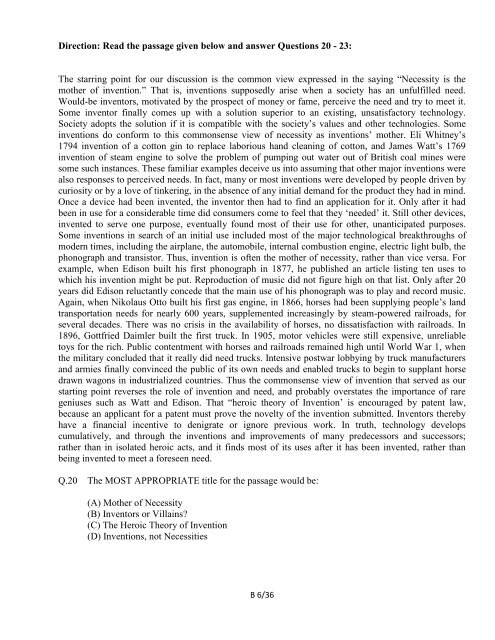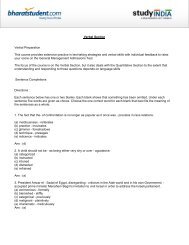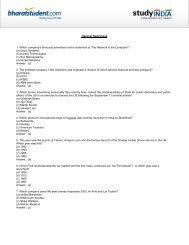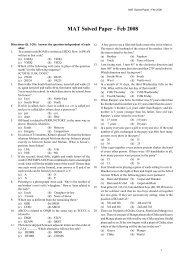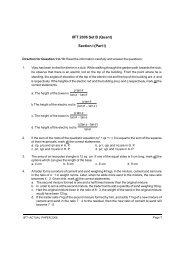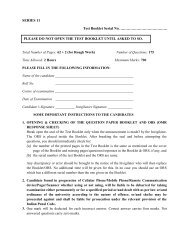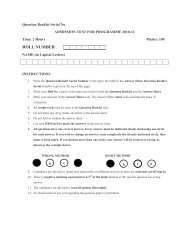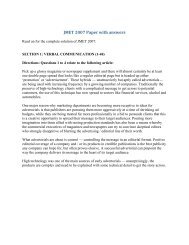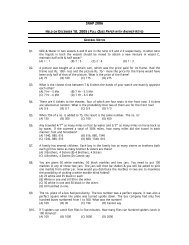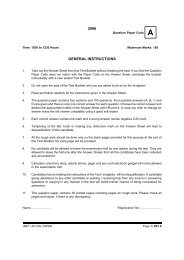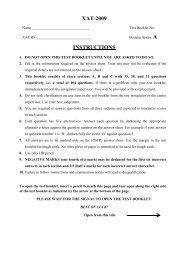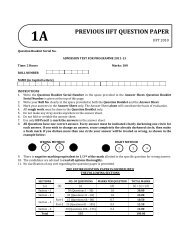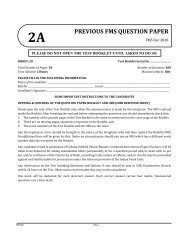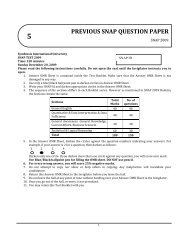JMET 2009 - Testfunda
JMET 2009 - Testfunda
JMET 2009 - Testfunda
You also want an ePaper? Increase the reach of your titles
YUMPU automatically turns print PDFs into web optimized ePapers that Google loves.
Direction: Read the passage given below and answer Questions 20 - 23:<br />
The starring point for our discussion is the common view expressed in the saying ―Necessity is the<br />
mother of invention.‖ That is, inventions supposedly arise when a society has an unfulfilled need.<br />
Would-be inventors, motivated by the prospect of money or fame, perceive the need and try to meet it.<br />
Some inventor finally comes up with a solution superior to an existing, unsatisfactory technology.<br />
Society adopts the solution if it is compatible with the society‘s values and other technologies. Some<br />
inventions do conform to this commonsense view of necessity as inventions‘ mother. Eli Whitney‘s<br />
1794 invention of a cotton gin to replace laborious hand cleaning of cotton, and James Watt‘s 1769<br />
invention of steam engine to solve the problem of pumping out water out of British coal mines were<br />
some such instances. These familiar examples deceive us into assuming that other major inventions were<br />
also responses to perceived needs. In fact, many or most inventions were developed by people driven by<br />
curiosity or by a love of tinkering, in the absence of any initial demand for the product they had in mind.<br />
Once a device had been invented, the inventor then had to find an application for it. Only after it had<br />
been in use for a considerable time did consumers come to feel that they ‗needed‘ it. Still other devices,<br />
invented to serve one purpose, eventually found most of their use for other, unanticipated purposes.<br />
Some inventions in search of an initial use included most of the major technological breakthroughs of<br />
modern times, including the airplane, the automobile, internal combustion engine, electric light bulb, the<br />
phonograph and transistor. Thus, invention is often the mother of necessity, rather than vice versa. For<br />
example, when Edison built his first phonograph in 1877, he published an article listing ten uses to<br />
which his invention might be put. Reproduction of music did not figure high on that list. Only after 20<br />
years did Edison reluctantly concede that the main use of his phonograph was to play and record music.<br />
Again, when Nikolaus Otto built his first gas engine, in 1866, horses had been supplying people‘s land<br />
transportation needs for nearly 600 years, supplemented increasingly by steam-powered railroads, for<br />
several decades. There was no crisis in the availability of horses, no dissatisfaction with railroads. In<br />
1896, Gottfried Daimler built the first truck. In 1905, motor vehicles were still expensive, unreliable<br />
toys for the rich. Public contentment with horses and railroads remained high until World War 1, when<br />
the military concluded that it really did need trucks. Intensive postwar lobbying by truck manufacturers<br />
and armies finally convinced the public of its own needs and enabled trucks to begin to supplant horse<br />
drawn wagons in industrialized countries. Thus the commonsense view of invention that served as our<br />
starting point reverses the role of invention and need, and probably overstates the importance of rare<br />
geniuses such as Watt and Edison. That ―heroic theory of Invention‘ is encouraged by patent law,<br />
because an applicant for a patent must prove the novelty of the invention submitted. Inventors thereby<br />
have a financial incentive to denigrate or ignore previous work. In truth, technology develops<br />
cumulatively, and through the inventions and improvements of many predecessors and successors;<br />
rather than in isolated heroic acts, and it finds most of its uses after it has been invented, rather than<br />
being invented to meet a foreseen need.<br />
Q.20 The MOST APPROPRIATE title for the passage would be:<br />
(A) Mother of Necessity<br />
(B) Inventors or Villains?<br />
(C) The Heroic Theory of Invention<br />
(D) Inventions, not Necessities<br />
B 6/36


